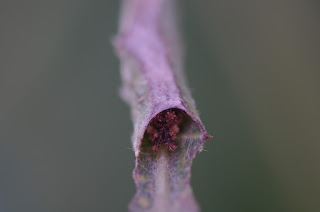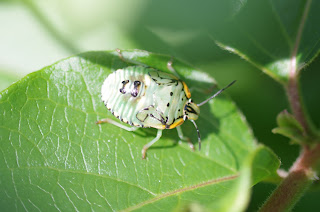As of today, it is autumn by 3 of the 4 metrics we use to determine the seasons. It is September, which is the start of autumn be meteorological reckoning. It is after Labor Day, which is the last day of what we could call social summer. And school has started, which marks the end of summer vacation, which doesn't matter to everyone, and happens for a lot of kids (and teachers) sometime in the middle of August. When I was a kid, school started the day after Labor Day, no matter what that date was, so those two versions of the end of summer coincided. Funny, though, that these things are more about the end of summer than the beginning of autumn. And astronomical autumn, as in "The First Day of Autumn" doesn't happen for a couple more weeks. Not that the earth actually cares how we determine these things. Leaves have already begun to change, and more than a few have come wafting down.
The change in seasons is pretty important to bugs, though. Take monarch butterflies, for example. I haven't been able to find a definitive answer (because the internet is the way it is), but there are 3-5 generations of monarchs every year. Most of them live as butterflies for about a month, but the last generation each summer is the super-generation, and these are the butterflies that migrate to Mexico for the winter. They can live for about 8 months, and make an incredible flight south. I was wondering what it is that makes that generation different, because they must be physically different somehow if they live so much longer and can make that trek, and the site I found that discussed it was pretty vague. There are daylight clues–the shortening of the days. It also said something about the diminishing quality of the milkweed food source, and I have definitely found that to be true; the plants are tougher and drier now. It is interesting, though, that lower quality food would produce stronger butterflies. I am pretty sure that the monarchs I have been releasing for the last few weeks are super-generation monarchs who are now flying south for the winter. And an interesting thing I have noticed is that for a while there it was hard for me to find milkweed to feed the caterpillars that didn't already have young caterpillars or even eggs on it, but it has now been weeks since I have seen either. The smallest of my 3 remaining caterpillars was about half an inch long when I adopted it about 2 weeks ago. I like to think of my butterflies making that incredible journey.
Here's one of them on its first leg of the flight:
All three of the butterflies that I released today were ready to fly when I took them outside. The first two I expected to eclose early, based on the fact that they looked totally ready last night. I know they came out before 10:30, because that's when I first checked on them, but they could have been out for hours by then. I released them a little after noon, and this was the first one. This is the only picture I got of it, with my iPod, because I was being clumsy with a butterfly on one hand and the iPod in the other, and the butterfly only stayed on my hand for less than a minute.
This one flew even faster–it took off the second I let go of its wings, and landed in this tree. I think it was less than a minute later it had gone off again, and I didn't even see it go.
The third one posed for a couple of photos, but then it too flew away pretty fast.
But it came back! At least, I think this is him; it definitely flew like a butterfly that had not been flying long. After it flew away the firs time I hung around the backyard a bit longer, taking a few more bug pictures, but then just sitting at the picnic table enjoying the beautiful day. Suddenly it fluttered back from who knows where, danced past me and landed in this tree. It only stayed a few minutes, and I watched it fly off again. It was a charming sight.
Backyard Bug of the Day:
I feel ridiculously proud of myself when I not only find caterpillars in the field guide, but find them in the section of the book where I first look for them–that implies that I know a little bit about what I am doing, and can at least recognize what family they belong in, even if I don't know the species. I was correct that this is a species of prominent. It is a double-toothed prominent. My thought as I looked at it was that it looks like it is related to Godzilla, so I got a bit of a chuckle when I read in Caterpillars of Eastern North America by David L. Wagner that this is "The stegosaurus of our caterpillar fauna..."
Looking around at the plants near where I found it I realized that there were a couple more.
This one is smaller than the others.
The small viceroy caterpillar on the back porch tree made itself a tiny hideaway with the remains of the leaf it ate yesterday.
The caterpillar book (title above) says that they overwinter as caterpillars in a "silken hibernaculum," which they said is a rolled leaf. I can't believe it would be getting ready for winter already, especially when it was 85ºF today.
It came out later in the day for a while, but then when I looked in the evening it had gone back in.
I am not 100% certain that this is a viceroy, because as it turns out, the red-spotted purple caterpillar is similar, and I did see red-spotted purples in my backyard, that looked like they laid eggs on this very tree, but the r-sp is supposedly not as spiky as the viceroy, and this is pretty spiky.
Other Bugs:
I have been trying to get a picture of this bug for about a week now. This is the first shot I've been able to get. This, by the way, is that plant that is so abundantly in bloom, and covered with bees, wasps, and flies. But I swear, the bugs on this plant look like they're being played on fast forward. Especially with my camera on the fritz, they're just too fast for me to get pictures.
Rove beetle. I know these are horrible pictures, but it's been a while since I have seen one of these, and it was so cute, I had to post it.
Fall webworm moths. A couple were outside the tent today.
Tree cricket
Looper
Around this time of year I start to find random insect wings.
Still just sitting around on that leaf. I don't know how this thing is ever going to become a moth.
Another test of your bug-spotting skills. This one's pretty easy.
Tree cricket
Stinkbug nymph
Arachnid Appreciation:
.
.
.
.
.
.
.
.
.
.
.
.
Again, I know, bad pictures, but I had to show you the spiderlings I found today. Which ended up all over me and my camera. I am pretty sure they were all unharmed.
A glaring omission in all of the spider pictures this last few days has been jumping spiders. I was happy to finally find one today.































No comments:
Post a Comment